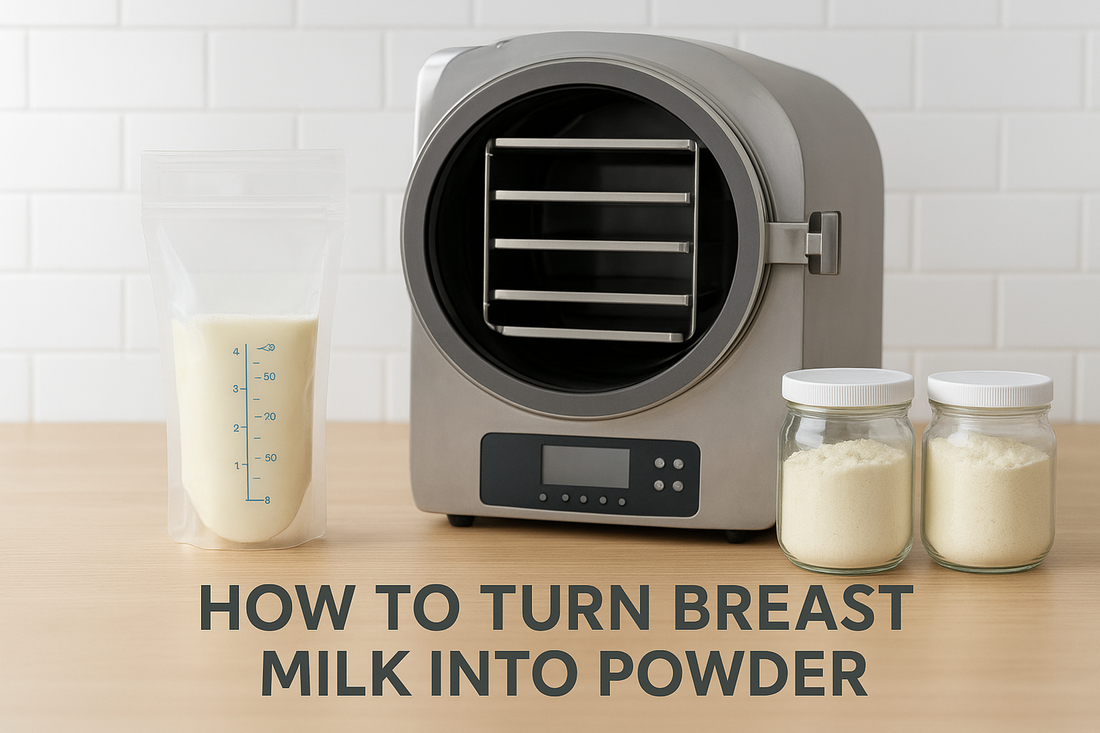
How to Turn Breast Milk into Powder
Share
For breastfeeding mothers, preserving every drop of milk is precious. Whether you’re returning to work, planning to travel, or simply building a milk stash, turning breast milk into powder offers a long-term, nutrient-preserving solution. In this detailed guide, we’ll explain how to turn breast milk into powder, explore the freeze-drying milk process, and discuss the best storage methods for your powdered milk.
You’ll also learn about the benefits of powdered breast milk, how it compares to traditional freezing, and what you need to know before using an at-home freeze dryer.
Understanding Why Mothers Choose to Powder Breast Milk
Breast milk is known as liquid gold — rich in antibodies, enzymes, fats, and nutrients that boost your baby’s immunity and growth. However, fresh or frozen breast milk has a limited shelf life. Converting milk into powder ensures long-term milk preservation without compromising nutritional value.
Powdered milk is:
-
Easy to store and transport
-
Shelf-stable for months without freezing
-
Quick to prepare when needed
- Ideal for travel, daycare, and emergency use
With services like WonderBewbz offering professional freeze-dried breast milk powder, mothers can preserve their milk safely and conveniently.
The Science Behind Freeze-Drying Breast Milk
Freeze-drying milk—also called lyophilization—is a gentle dehydration process that removes water from breast milk while retaining its nutrients. Unlike heating or boiling, this process preserves the milk’s structure, enzymes, and antibodies.
The Steps Involved:
-
Freezing the Milk – Freshly expressed breast milk is frozen at extremely low temperatures to lock in nutrients.
-
Vacuum Dehydration – The frozen milk is placed in a vacuum chamber where moisture evaporates without heat.
-
Powder Formation – Once water is removed, the milk becomes a fine, dry powder.
-
Sealed Packaging – The powdered milk is sealed in airtight pouches to prevent exposure to air and moisture.
This method is far superior to traditional dehydration techniques because it avoids nutrient degradation and preserves the natural taste of breast milk.
Learn more about breast milk storage to maintain safety and freshness before freeze-drying.
Can You Freeze-Dry Breast Milk at Home?
Many parents wonder if they can use an at-home freeze dryer to powder their breast milk. While technically possible, it requires specialized equipment and precise temperature control. Most home freeze dryers are expensive and require regular maintenance to ensure safe, contamination-free processing.
If you’re looking for a convenient and hygienic option, consider professional freeze-drying services like WonderBewbz’s freeze-dried breast milk powder — where your milk is carefully processed and returned to you as nutrient-rich powder, ready for reconstitution.
The Freeze-Drying Process Explained in Detail
Let’s take a closer look at how freeze-drying works to create powdered breast milk that’s safe for your baby.
1. Freezing the Milk
Your fresh milk is frozen immediately after expression to preserve quality. This prevents bacterial growth and maintains enzymes and antibodies.
2. Sublimation (Vacuum Dehydration)
The frozen milk is placed in a vacuum chamber. The water inside turns directly from ice to vapor, bypassing the liquid stage. This dehydration process protects heat-sensitive nutrients from being destroyed.
3. Packaging and Storage
The resulting fine powder is sealed in moisture-proof, oxygen-free packaging. This ensures the milk remains stable for months or even years under proper storage conditions.
Benefits of Turning Breast Milk into Powder
Transforming breast milk into powder offers numerous advantages beyond convenience:
1. Extended Shelf Life
Powdered milk lasts far longer than refrigerated or frozen milk. It can be stored for months at room temperature without spoiling.
2. Space Saving
No need for bulky freezers or coolers—powdered milk takes minimal space.
3. Travel-Friendly
Ideal for mothers who travel frequently or need to send milk to caregivers or daycare centers.
4. Nutrient Preservation
Freeze-drying preserves up to 97% of nutrients, making it superior to boiling or traditional dehydration.
5. Ease of Rehydration
Just add warm, sterile water and shake well to recreate a fresh milk consistency instantly.
Proper Storage Methods for Powdered Breast Milk
Once your milk has been powdered, correct storage is crucial for maintaining its nutritional integrity.
-
Use Airtight Containers – Keep powdered milk in vacuum-sealed or airtight jars.
-
Avoid Moisture – Even a small amount of humidity can spoil powdered milk.
-
Store in a Cool, Dry Place – Away from sunlight or high heat.
-
Label Clearly – Include the date of expression and freeze-drying for easy tracking.
Check out breast milk freezer tips and how long breast milk lasts in the fridge for more information on milk preservation before powdering.
How to Reconstitute Powdered Breast Milk
When you’re ready to feed your baby, it’s easy to bring powdered milk back to liquid form.
Steps:
-
Use clean, sterilized bottles and water.
-
Mix the correct amount of warm water with powdered milk.
-
Shake well until fully dissolved.
-
Test the milk temperature for baby before feeding.
Always follow the rehydration instructions provided by your freeze-drying service for accurate results.
Comparing Powdered Breast Milk and Frozen Milk
|
Feature |
Powdered Breast Milk |
Frozen Breast Milk |
|
Shelf Life |
6–12 months |
6–12 weeks |
|
Storage |
Room temperature |
Requires freezer |
|
Preparation |
Just add water |
Must thaw and warm |
|
Nutrient Retention |
95–97% |
80–90% |
|
Portability |
High |
Limited |
Foods and Habits That Support Milk Supply
If you’re planning to build a freezer stash before powdering your milk, it’s essential to maintain a healthy lactation routine. Eating foods to increase breast milk and drinking plenty of fluids can naturally boost milk supply.
Common Myths About Powdering Breast Milk
-
“Powdering milk destroys nutrients.”
– False. Freeze-drying preserves up to 97% of nutrients.
-
“It’s unsafe for babies.”
– Incorrect. When done professionally, the milk remains sterile and nutrient-rich.
-
“Homemade methods work just as well.”
– Not true. Only vacuum freeze-drying maintains full nutritional integrity.
Is Powdered Breast Milk Safe for Newborns?
Yes, powdered breast milk—especially when professionally processed—is safe for newborns. It retains antibodies and nutrients that are essential for immune support. Just ensure you use sterile water and follow correct rehydration methods.
When Should You Consider Turning Milk into Powder?
You might choose powdered milk if you:
-
Plan to return to work or travel often
-
Have a large milk supply and limited freezer space
-
Want emergency milk storage for unpredictable situations
-
Need easy milk transport for caregivers
Conclusion
Converting breast milk into powder is one of the most efficient ways to ensure long-term milk preservation while retaining maximum nutrition for your baby. The freeze-drying milk process may sound technical, but with professional help from WonderBewbz, it becomes simple, safe, and incredibly beneficial for mothers who value both convenience and care.
Whether you’re looking for expert freeze-drying services or guidance on milk handling, WonderBewbz offers all the support you need to make the most of your precious liquid gold.
Frequently Asked Questions
How long does powdered breast milk last?
Properly sealed powdered breast milk can last up to a year when stored in a cool, dry environment away from sunlight.
Can I freeze-dry milk that was previously frozen?
Yes, frozen milk can be thawed and then freeze-dried, provided it was stored safely and hasn’t exceeded its usable duration.
Does powdered breast milk taste different?
Slightly. It might have a milder or less creamy taste, but it remains safe and nutritious.
How much water should I add to reconstitute powdered breast milk?
Follow the ratio recommended by your freeze-drying service, as it depends on the dehydration level.
Can I use powdered breast milk for preemies?
Yes, as long as the milk has been safely processed and your pediatrician approves, it’s suitable for preterm babies.
What’s the difference between freeze-drying and dehydration?
Freeze-drying uses low temperatures and vacuum pressure, while dehydration uses heat, which can damage nutrients.
Is an at-home freeze dryer safe for milk?
It can be used with caution, but professional services ensure better sterilization and quality control.
Can I mix powdered breast milk with formula?
It’s best to consult your pediatrician before combining different feeding sources.
How can I ensure the milk remains sterile after rehydration?
Always use sterilized bottles, utensils, and boiled or filtered water for preparation.
Is powdered breast milk as nutritious as fresh milk?
Almost. Freeze-drying retains up to 97% of nutrients, making it one of the closest alternatives to fresh milk.
